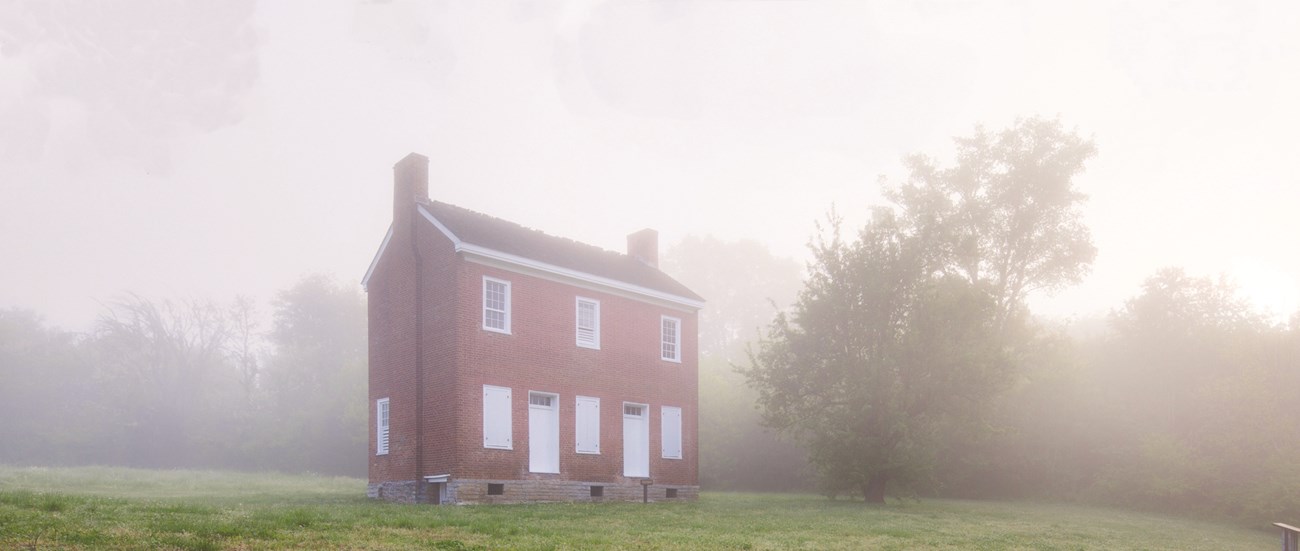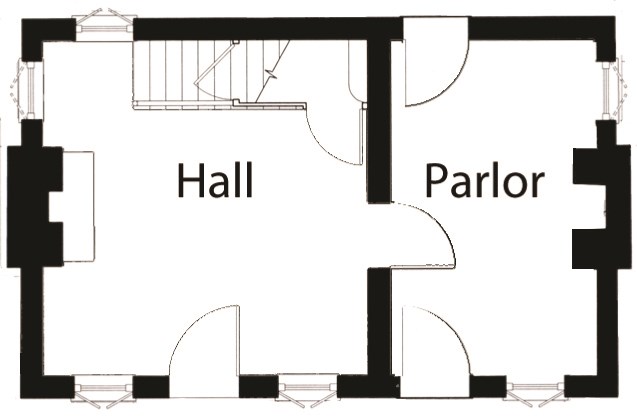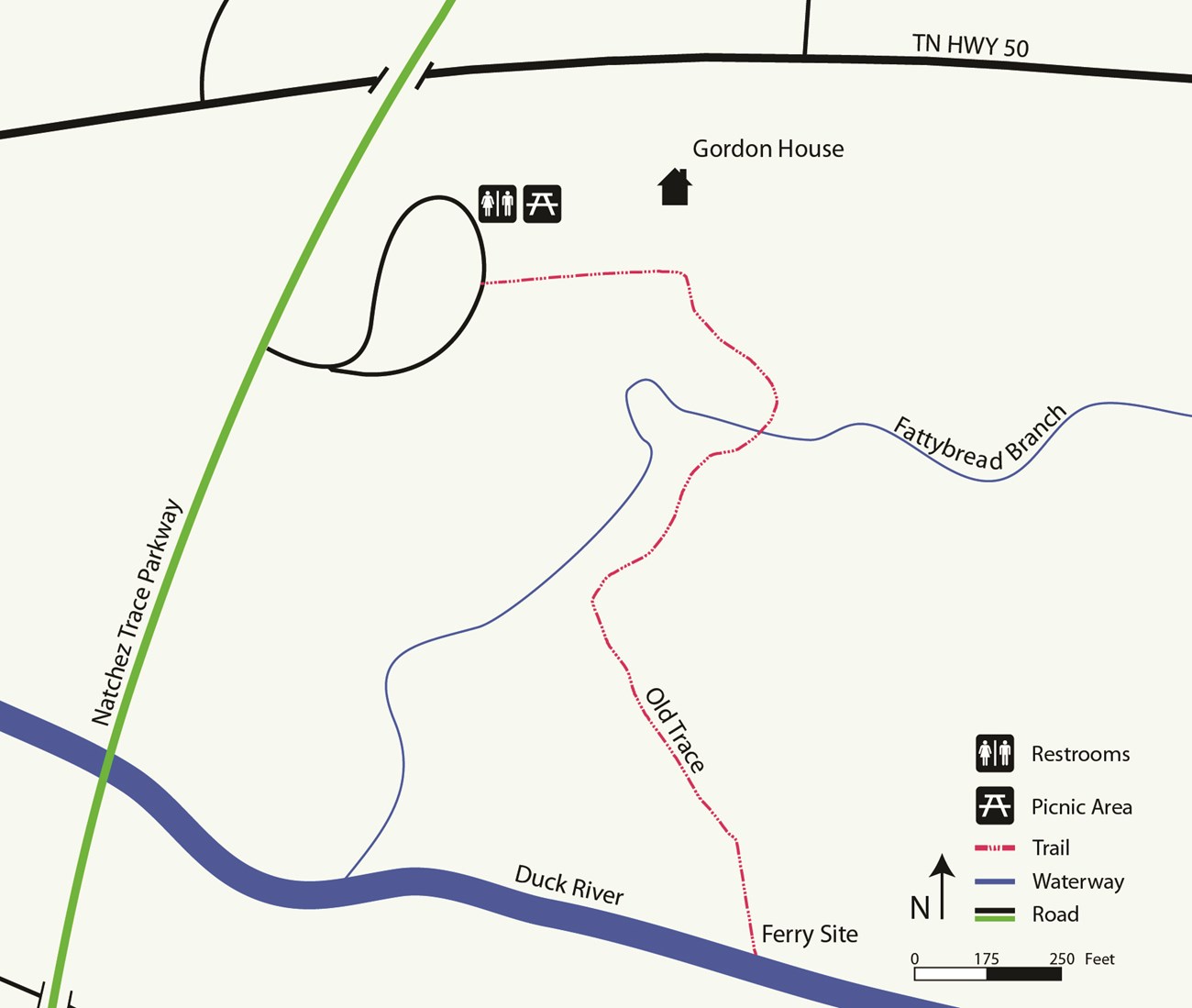
Copyright Marc Muench,
Somewhat stark and a little imposing, the Gordon House you see today masks the welcome it once gave to travelers and locals alike. The brick home of Captain John Gordon and his family, built in 1818, was one of the more impressive homes in the area. It was a landmark for travelers of the Old Trace, letting them know that soon they would be in Nashville, Tennessee, where simple human comforts could be found after weeks of walking on a well-traveled but rustic trail. The Gordon family called it home, but it was a business as well. A ferry provided a safe way for travelers and locals alike to cross the Duck River, and the grounds provided boatmen on their way home a place to sleep for the night. Who was John Gordon? Postmaster, trader, farmer, captain, and entrepreneur are all careers that John Gordon held during his 56-year life. As the father of 11 children, he and his wife Dolly were looking for opportunities to provide for their family. In the early 1800s, this site was just inside Chickasaw Territory, and any business needed a Chickasaw representative. In 1802, a partnership formed between Gordon and Chickasaw Chief William Colbert. Gordon operated a ferry across the Duck River, a stand for weary travelers, and a trading post years before he and his family would move to this site they would call home. Gordon, his wife Dolly, and their children permanently moved from Nashville to the Duck River site in 1812, according to family records. Shortly after the family arrived, Gordon left home to serve his country. Captain Gordon and the War of 1812 Gordon became Captain of the Spies (the leader of one of two scouting units) for Andrew Jackson during the Creek War, often considered part of the War of 1812. Gordon was active from the Battle of Talladega in 1813, through the Battle of Horseshoe Bend in 1814. He was seen as a leader, and had the ability to improve moral and keep troops motivated. On multiple occasions, Gordon received General Jackson’s praises: “Capt. Gordon who was in front at [the head] of the spies rushed, to the fight, and entered into the persuit [sic]...” Letter from Andrew Jackson to Rachel Jackson, 1814. As Jackson’s “faithful spy,” Gordon continued to assist him, even after the War of 1812. He was also instrumental in the Seminole War. Gordon and the rest of Jackson’s troops made settlers feel safe, but it came at a cost to the Creek Indians. They were forced to give up 23 million acres of their homeland. Building the Gordon House While Gordon was away again in 1818, Dolly maintained the home front. Gordon did, however, send her instructions at least once on how their new house should be built. “The windows to be placed on each side of the front door of the large room, and on the right of the door of the small room… The rest I leave with yourself.” Letter from John Gordon to Dolly Gordon, 1818. The house layout was typical for the time—a Federal-style, modified hall-and-parlor plan—but the brick from which it was made created one of the most elegant homes on the Tennessee frontier. 
NPS Even though you cannot enter the Gordon House today due to safety concerns, you can imagine a large, vibrant family filling the home. If we could pull back the curtains, we may see a well-worn floor from children playing. Through one front door, you may imagine seeing the family gathered around the fireplace—a room where many daily activities took place. The narrow staircase leads upstairs to two bedrooms. Through the other front door, you would see the formal parlor, where guests would visit during the day, or where people would sleep at night. The Gordon House was not the only building on the land, as you see today. An exterior kitchen, a smokehouse, barns, coops, and servant’s quarters are all possible buildings that filled the 1,515 acre site. From Family Home to Historic Site Shortly after the Gordon House was completed, travel on the Old Trace started to slow down and almost came to a stop. The stand and trading post were no longer necessary, but the ferry remained operational for almost 100 years due to the high use by local residents. It was not until 1896, when a bridge was built over the Duck River, that the ferry was abandoned. When John Gordon died of pneumonia in 1819, Dolly continued to run the farm with the help of her children and enslaved people. Cotton, cattle, and hogs all helped to support her family. At the time of her death at the age of 80, her son-in-law wrote, “She bore the burdens of their home, and was as brave and heroic as he.” She lived here until her death in 1859. The Gordon House had numerous owners before the National Park Service acquired the site in 1973. In 1974, the home was nominated and listed on the National Register of Historic Places. The exterior was soon restored to its 1818 appearance, as you see it today. Your Visit to the Gordon House Site The Gordon House, one of only two structures left standing on the Parkway from the era of the Old Trace, remains as a sentinel over the Duck River crossing. Take a walk around the house, then work your way to Fattybread Branch. You will be walking on the Old Trace, just as thousands of travelers did before you, as you approach the bridge over the creek. Continue on the Old Trace, and you will find the Duck River. Where the creek meets the river is likely the location of wooden structures that housed weary travelers who had crossed the Duck River on Gordon’s ferry. 
NPS |
Last updated: April 20, 2021
